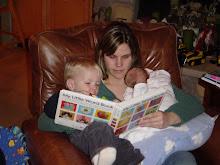One big health hot topic today is in regard to plastics and whether or not they contain BPA, phthalates, and/or PCV - all of which have been deemed "bad", especially when heated as some plastics will then breakdown and release the toxin(s). Click here for a recent story on this by MSNBC.
This is obviously a huge concern for parents because plastics are in things like baby bottles, pacifiers, teething rings, formula, and toys - in short, things that have direct contact with our children. SO, how do we know what plastics are "ok" (at least by today's standards) and what plastics are not? Here is an excellent resource to help:
There is conflicting information out there of course and it's enough to make my head spin. For instance, although we've heard a #7 recycling code is "bad", apparently that's not totally true. Check this blog out at The Soft Landing for further details. The fact that no explicit rules exist is enough to make my head spin.
Like many in tune with this issue I will likely error on the side of caution and stick to using glass or plastics with recycling codes 4, 5, 1 or 2. But I'm not sure what to do with those items that have no recycling codes other than toss or call the manufacturer.
Below are other resources I've either found or have been referred to me that help make sense of it all and assist with your shopping for new products as well.


No comments:
Post a Comment